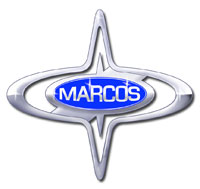
The Ford GT40 is a 1960s high-performance endurance racing car designed and built for and by the Ford Motor Company "Ford GT" project, an effort to compete in European long-distance sports car races, against Scuderia Ferrari, which had won the prestigious 24 Hours of Le Mans race from 1960 to 1965. Around 100 cars have been made, mostly as 4.7 litre "289" V8 mid-engined sportscars, some sold to private teams or as road legal Mk.III cars. Racing started in 1964, with Ford winning World Championships categories from 1966 to 1968. The first Le Mans 24h race win came in 1966 with two 7.0 litre "427" powered Mk.II prototypes crossing the finish line together, the second in 1967 by a 7.0 litre highly modified US-built Mk.IV "J-car" prototype. Considered too fast, a rule change from 1968 onwards limited prototypes to 3.0 litre Formula 1 engines, yet the private JW "Gulf" team collected additional Le Mans wins in 1968 and 1969 with the very same "old" Mk.I GT40 sportscar, still allowed with up to 5.0 litre engines when at least 25 had been made.

The Lamborghini Diablo is a high-performance mid-engine sports car built by Italian automobile manufacturer Lamborghini between 1990 and 2001. It is the first production Lamborghini capable of attaining a top speed in excess of 200 mph (320 km/h). After the end of its production run in 2001, the Diablo was replaced by the Lamborghini Murciélago. The name Diablo means "devil" in Spanish.

The Reliant Scimitar name was used for a series of sports car models produced by British car manufacturer Reliant between 1964 and 1986. During its 22-year production it evolved from a coupe (GT) into a sports estate (GTE), with a convertible variant (GTC) launched in 1980. All have a fibreglass body mounted on a steel box-section chassis, and Ford engines.

The McLaren F1 is a sports car designed and manufactured by British automobile manufacturer McLaren Cars and powered by the BMW S70/2 V12 engine. The original concept was conceived by Gordon Murray, who successfully convinced Ron Dennis to back the project and hired car designer Peter Stevens to design the exterior and interior of the car. On 31 March 1998, the XP5 prototype with a modified rev limiter set the Guinness World Record for the world's fastest production car, reaching 240.1 mph (386.4 km/h), surpassing the modified Jaguar XJ220's 218.3 mph (351 km/h) record from 1993.

Marcos Engineering was a British sports car manufacturer. The name derives from the surnames of founders Jem Marsh and Frank Costin.

The Porsche Carrera GT is a mid-engine sports car that was manufactured by German automobile manufacturer Porsche from 2004 to 2006. Sports Car International named the Carrera GT number one on its list of Top Sports Cars of the 2000s, and number eight on its Top Sports Cars of All Time list. For its advanced technology and development of its chassis, Popular Science magazine awarded it the "Best of What's New" award in 2003.

The Ford GT is a mid-engine two-seater sports car manufactured and marketed by American automobile manufacturer Ford for the 2005 model year in conjunction with the company's 2003 centenary. The second generation Ford GT became available for the 2017 model year.

The Holden Torana is a mid-sized car that was manufactured by Holden from 1967 to 1980. The name apparently comes from a word meaning "to fly" in an unconfirmed Aboriginal Australian language. The original HB series Torana was released in 1967 and was a four-cylinder compact vehicle closely based on the British Vauxhall Viva HB series of 1966–1970.

The Shelby Mustang is a high-performance variant of the Ford Mustang built by Shelby American from 1965 to 1967 and by the Ford Motor Company from 1968 to 1970.

The Ford GT90 is a high performance concept car that was developed and manufactured by American car maker Ford. It was unveiled in January 1995 at the Detroit Auto Show. The car is currently on display at Hajek Motorsports Museum, Ames, Oklahoma.

The Morgan Aero 8 is a sports car built by Morgan Motor Company at its factory in Malvern Link, England from 2000 until 2018.

Ginetta Cars Limited is a British specialist builder of racing and sports cars based in Garforth, Leeds, West Yorkshire.

Turner Sports Car Company Limited was a 1950s British sports car manufacturer, that closed in 1966.

The Mercedes-Benz CLK GTR is a GT1 sports car built and produced by Mercedes-Benz in conjunction with their then motorsport partner AMG. Intended for racing in the new FIA GT Championship series in 1997, the CLK GTR was designed primarily as a race car. As such, the production of road cars necessary in order to meet homologation standards of GT1 was a secondary consideration in the car's design, i.e. the CLK GTR was a homologation special.

Shelby American, Inc. is an American high performance automobile company founded by driver Carroll Shelby. The Shelby American name has been used by several legally distinct corporations founded by Shelby since his original shop in Venice, California began operation in 1962. The current iteration is a wholly owned subsidiary of Carroll Shelby International, Inc., a holding company formed in 2003. Carroll Shelby International's other wholly owned subsidiary is Carroll Shelby Licensing, which licenses the name and trademarks associated with Shelby to other companies. Shelby American was the first automobile manufacturer in the state of Nevada. Shelby American manufactures component automobiles, including replicas of the small-block and large-block AC Cobras, the Shelby GT350 and the GT500 Super Snake. Since 2005, Shelby American has released new models each year.

The Ford P68, also commonly known as the Ford 3L GT or F3L, is a sports prototype racing car model introduced in March 1968. It was designed by Len Bailey, a Ford research engineer, funded by Ford Europe and built by Alan Mann Racing at Weybridge, Surrey, UK. The first competition appearance of a Ford 3L prototype was at the BOAC 500 race at Brands Hatch in Kent. It delivered a good pace, but was criticized for instability at high speeds. It did not finish any of the races in which it was entered, due to mechanical and electrical failures.

Superformance LLC is an American automobile company that builds, designs, develops, engineers and markets sports cars, related performance components and full replicars. The company was founded as "Superformance International Inc." by Hi-Tech Automotive Ltd. in 1996. Today, Superformance has 15 authorized dealers in the United States and 6 international dealers. SPF cars are sold as "turnkey-minus replacers". In December, 2005 Hi-Tech Automotive transferred the ownership of its subsidiary, Superformance, to American Hillbank Automotive Group, which is a privately owned business of American entrepreneur Lance Stander. Hi-Tech Automotive continue to build Superformance cars at its plant in Port Elizabeth, South Africa.

The Nissan GT-R is a car built by Japanese marque Nissan since 2007. It has a 2+2 seating layout and is considered both a sports car and a grand tourer. The engine is front-mid mounted and drives all four wheels. It succeeds the Nissan Skyline GT-R, a faster variant of the Nissan Skyline. Although this model was the sixth-generation to bear the GT-R name, it is no longer part of the Skyline line-up. The car is built on the PM platform, derived from the FM platform used in the Skyline and Nissan Z models. Production is conducted in a shared production line at Nissan's Tochigi plant in Japan.

The McLaren P1 is a flagship sports car produced by British marque McLaren Automotive. Styled by American car designer Frank Stephenson, it is the second installment in McLaren's Ultimate Series after the McLaren F1. Considered to be the spiritual successor to the F1, the P1 was one of the first high performance sports cars to be introduced incorporating hybrid technology; the Porsche 918 Spyder having begun taking orders prior to the P1 and the LaFerrari introduced alongside it. First shown as a concept on the 20th anniversary of the F1 at the 2012 Paris Motor Show, the P1 made its debut at the 2013 Geneva International Motor Show.

The Lola Mk6 GT was a racing car with a production run of only three units, built between 1962 and 1963 by British car manufacturer Lola Cars. With its 289 cu in (4.74 L) Ford V8 engine, the Mk6 GT was the first mid-mounted, high displacement V8-powered Grand Touring car, a chassis arrangement that had been used, up until that time, only on formula cars and smaller, more affordable GTs.



















